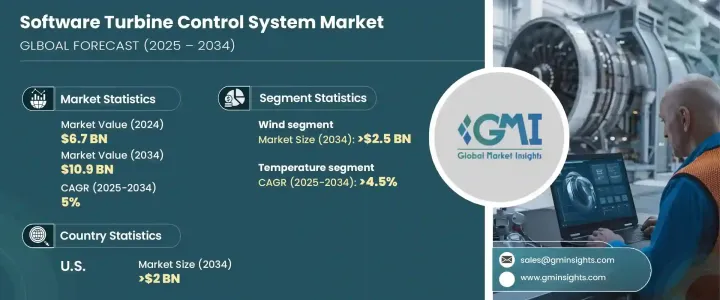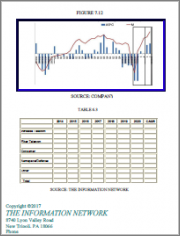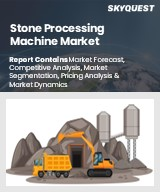
|
시장보고서
상품코드
1684556
소프트웨어 터빈 제어 시스템 시장 : 기회, 성장 촉진요인, 산업 동향 분석(2025-2034년)Software Turbine Control System Market Opportunity, Growth Drivers, Industry Trend Analysis, and Forecast 2025 - 2034 |
||||||
세계의 소프트웨어 터빈 제어 시스템 시장은 2024년 67억 달러로 평가되었으며, 2025년부터 2034년까지 연평균 성장률(CAGR) 5%로 성장할 것으로 예측됩니다.
이러한 급증은 주로 연료 소비 최적화, 운영 효율성 향상, 값비싼 다운타임 최소화에 초점을 맞추는 업계에 의해 주도되고 있습니다. 머신러닝(ML), 인공지능(AI), 사물인터넷(IoT)의 기술 발전으로 기업은 이제 실시간 모니터링 및 예측 분석 기능을 갖추고 운영 중단을 줄이고 생산성을 높이고 있습니다. 이러한 혁신은 터빈 시스템의 운영 방식을 변화시키고 있으며, 발전부터 석유 및 가스까지 다양한 분야의 비즈니스에 없어서는 안 될 필수 요소로 자리 잡고 있습니다. 지속 가능성에 대한 추구와 재생 에너지의 채택은 시장 성장을 촉진하는 또 다른 주요 요인입니다. 업계가 엄격한 배출 기준을 충족하고 효율성을 높이기 위해 노력함에 따라 소프트웨어 터빈 제어 시스템은 현대 에너지 관리의 필수 도구가 되고 있습니다.

재생 에너지 부문이 빠르게 성장함에 따라 소프트웨어 터빈 제어 시스템은 터빈의 성능과 신뢰성을 최적화하는 데 더욱 중요해졌습니다. 특히 풍력 터빈 제어 시스템 부문은 2034년까지 25억 달러의 매출을 올릴 것으로 예상됩니다. 이러한 성장은 기술 혁신, 강력한 정책적 지원, 재생 에너지로의 전환을 위한 전 세계적인 노력에 힘입어 가속화되고 있습니다. 보조금 및 세금 혜택과 같은 정부 인센티브는 풍력 에너지 프로젝트에 대한 투자를 촉진하고 있으며, 첨단 터빈 제어 시스템의 도입은 이러한 노력의 필수 요소로 자리 잡았습니다. 전 세계가 청정 에너지원을 우선시하는 가운데, 그리드 안정성과 에너지 신뢰성에 대한 정부 규정을 충족하는 것이 그 어느 때보다 중요해졌습니다.
| 시장 범위 | |
|---|---|
| 시작 연도 | 2024년 |
| 예측 연도 | 2025-2034년 |
| 시작 금액 | 67억 달러 |
| 예측 금액 | 109억 달러 |
| CAGR | 5% |
온도별 터빈 제어 시스템 시장도 2034년까지 연평균 4.5%의 성장률을 보일 것으로 예상됩니다. 이러한 시스템은 특히 발전 및 제조 산업에서 정밀한 온도 제어를 통해 고장을 예방하는 데 매우 중요합니다. 장비 수명을 연장하고 운영을 최적화할 수 있는 보다 효율적이고 신뢰할 수 있는 시스템에 대한 수요가 증가하고 있습니다. 온도 모니터링 통합은 운영을 간소화하고 전반적인 성과를 개선하고자 하는 기업에서 표준 관행으로 자리 잡고 있습니다.
미국의 소프트웨어 터빈 제어 시스템 시장은 2034년까지 20억 달러에 달할 것으로 예상됩니다. 노후화된 발전소가 현대화되면서 터빈 성능을 최적화할 수 있는 에너지 관리 시스템에 대한 수요가 급증하고 있습니다. 재생 에너지와 분산형 에너지 자원의 통합과 고급 분석 및 실시간 모니터링이 결합되면서 시장 확대에 박차를 가하고 있습니다. 또한, 배출량을 줄이고 에너지 효율을 높이기 위한 주 및 연방 규제로 인해 업계는 최첨단 터빈 제어 시스템을 도입하여 시장의 견고한 성장을 주도하고 있습니다.
목차
제1장 조사 방법과 조사 범위
- 시장 범위와 정의
- 시장 추계 및 예측 파라미터
- 예측 계산
- 데이터 소스
- 1차
- 2차
- 유료
- 공적
제2장 주요 요약
제3장 업계 인사이트
- 업계 생태계 분석
- 규제 상황
- 업계에 미치는 영향요인
- 성장 촉진요인
- 업계의 잠재적 리스크 및 과제
- 성장 가능성 분석
- Porter's Five Forces 분석
- PESTEL 분석
제4장 경쟁 구도
- 소개
- 전략적 전망
- 혁신과 지속가능성의 전망
제5장 시장 규모와 예측 : 제품별(2021-2034년)
- 주요 동향
- 증기 터빈 제어 시스템
- 가스 터빈 제어 시스템
- 수력 터빈 제어 시스템
- 풍력 터빈 제어 시스템
- 기타
제6장 시장 규모와 예측 : 기능별(2021-2034년)
- 주요 동향
- 속도 제어
- 온도 제어
- 부하 제어
- 압력 제어
- 기타
제7장 시장 규모와 예측 : 지역별(2021-2034년)
- 주요 동향
- 북미
- 미국
- 캐나다
- 멕시코
- 유럽
- 영국
- 프랑스
- 독일
- 러시아
- 스페인
- 이탈리아
- 아시아태평양
- 중국
- 일본
- 한국
- 인도
- 호주
- 인도네시아
- 중동 및 아프리카
- 사우디아라비아
- 아랍에미리트(UAE)
- 이란
- 이집트
- 남아프리카
- 나이지리아
- 터키
- 라틴아메리카
- 브라질
- 아르헨티나
- 칠레
제8장 기업 프로파일
- ABB
- ANDRITZ
- Danfoss
- DEIF
- Eaton
- Emerson Electric
- Ethos Energy Group
- General Electric
- Heinzmann
- Honeywell International
- Ingeteam
- Mitsubishi Heavy Industries
- Rockwell Automation
- Schneider Electric
- Siemens Energy
- Sulzer
- Turbine Controls
- Valmet
- Voith
- Woodward
The Global Software Turbine Control System Market, valued at USD 6.7 billion in 2024, is projected to expand at a CAGR of 5% from 2025 to 2034. This surge is largely driven by industries focusing on optimizing fuel consumption, enhancing operational efficiency, and minimizing costly downtime. With technological advancements in machine learning (ML), artificial intelligence (AI), and the Internet of Things (IoT), companies are now equipped with real-time monitoring and predictive analytics capabilities, reducing operational disruptions and increasing productivity. These innovations are transforming the way turbine systems operate, making them indispensable for businesses across various sectors, from power generation to oil and gas. The push for sustainability and the adoption of renewable energy are additional key factors propelling market growth. As industries strive to meet stringent emission standards and boost efficiency, software turbine control systems are becoming an essential tool in modern energy management.

As the renewable energy sector grows rapidly, software turbine control systems have become even more crucial for optimizing the performance and reliability of turbines. In particular, the wind turbine control system segment is set to generate USD 2.5 billion by 2034. This growth is being fueled by technological innovations, strong policy backing, and global efforts to transition to renewable energy. Government incentives, such as subsidies and tax benefits, are spurring investment in wind energy projects, making the adoption of advanced turbine control systems an essential part of these initiatives. With the world prioritizing cleaner energy sources, meeting government regulations for grid stability and energy reliability has never been more important.
| Market Scope | |
|---|---|
| Start Year | 2024 |
| Forecast Year | 2025-2034 |
| Start Value | $6.7 Billion |
| Forecast Value | $10.9 Billion |
| CAGR | 5% |
The market for temperature-specific turbine control systems is also set to experience growth, with a projected CAGR of 4.5% through 2034. These systems are critical in preventing failures by ensuring precise temperature control, particularly in power generation and manufacturing industries. The demand for more efficient and reliable systems that can extend equipment lifespan and optimize operations is increasing. Integrating temperature monitoring is becoming a standard practice for businesses looking to streamline operations and improve overall performance.
In the United States, the software turbine control system market is forecast to generate USD 2 billion by 2034. As aging power plants undergo modernization, the demand for energy management systems that can optimize turbine performance is skyrocketing. The integration of renewable energy and distributed energy resources, combined with advanced analytics and real-time monitoring, is fueling market expansion. Additionally, state and federal regulations aimed at reducing emissions and boosting energy efficiency are pushing industries to adopt cutting-edge turbine control systems, driving the market's robust growth.
Table of Contents
Chapter 1 Methodology & Scope
- 1.1 Market scope & definitions
- 1.2 Market estimates & forecast parameters
- 1.3 Forecast calculation
- 1.4 Data sources
- 1.4.1 Primary
- 1.4.2 Secondary
- 1.4.2.1 Paid
- 1.4.2.2 Public
Chapter 2 Executive Summary
- 2.1 Industry synopsis, 2021 - 2034
Chapter 3 Industry Insights
- 3.1 Industry ecosystem analysis
- 3.2 Regulatory landscape
- 3.3 Industry impact forces
- 3.3.1 Growth drivers
- 3.3.2 Industry pitfalls & challenges
- 3.4 Growth potential analysis
- 3.5 Porter's Analysis
- 3.5.1 Bargaining power of suppliers
- 3.5.2 Bargaining power of buyers
- 3.5.3 Threat of new entrants
- 3.5.4 Threat of substitutes
- 3.6 PESTEL Analysis
Chapter 4 Competitive Landscape, 2024
- 4.1 Introduction
- 4.2 Strategic outlook
- 4.3 Innovation & sustainability landscape
Chapter 5 Market Size and Forecast, By Product, 2021 – 2034 (USD Million)
- 5.1 Key trends
- 5.2 Steam turbine control system
- 5.3 Gas turbine control system
- 5.4 Hydro turbine control system
- 5.5 Wind turbine control system
- 5.6 Others
Chapter 6 Market Size and Forecast, By Function, 2021 – 2034 (USD Million)
- 6.1 Key trends
- 6.2 Speed control
- 6.3 Temperature control
- 6.4 Load control
- 6.5 Pressure control
- 6.6 Others
Chapter 7 Market Size and Forecast, By Region, 2021 – 2034 (USD Million)
- 7.1 Key trends
- 7.2 North America
- 7.2.1 U.S.
- 7.2.2 Canada
- 7.2.3 Mexico
- 7.3 Europe
- 7.3.1 UK
- 7.3.2 France
- 7.3.3 Germany
- 7.3.4 Russia
- 7.3.5 Spain
- 7.3.6 Italy
- 7.4 Asia Pacific
- 7.4.1 China
- 7.4.2 Japan
- 7.4.3 South Korea
- 7.4.4 India
- 7.4.5 Australia
- 7.4.6 Indonesia
- 7.5 Middle East & Africa
- 7.5.1 Saudi Arabia
- 7.5.2 UAE
- 7.5.3 Iran
- 7.5.4 Egypt
- 7.5.5 South Africa
- 7.5.6 Nigeria
- 7.5.7 Turkey
- 7.6 Latin America
- 7.6.1 Brazil
- 7.6.2 Argentina
- 7.6.3 Chile
Chapter 8 Company Profiles
- 8.1 ABB
- 8.2 ANDRITZ
- 8.3 Danfoss
- 8.4 DEIF
- 8.5 Eaton
- 8.6 Emerson Electric
- 8.7 Ethos Energy Group
- 8.8 General Electric
- 8.9 Heinzmann
- 8.10 Honeywell International
- 8.11 Ingeteam
- 8.12 Mitsubishi Heavy Industries
- 8.13 Rockwell Automation
- 8.14 Schneider Electric
- 8.15 Siemens Energy
- 8.16 Sulzer
- 8.17 Turbine Controls
- 8.18 Valmet
- 8.19 Voith
- 8.20 Woodward



















